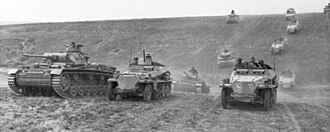
Back Blitzkrieg Afrikaans الحرب الخاطفة Arabic Blitzkrieg AST Blitzkriq Azerbaijani Бліцкрыг Byelorussian Маланкавая вайна BE-X-OLD Светкавична война Bulgarian Blitzkrieg Breton Blitzkrieg BS Guerra llampec Catalan

Blitzkrieg (/ˈblɪtskriːɡ/ BLITS-kreeg, German: [ˈblɪtskʁiːk] ⓘ; from Blitz "lightning" + Krieg "war") or bewegungskrieg is a word used to describe a combined arms surprise attack using a rapid, overwhelming force concentration that may consist of armored and motorized or mechanized infantry formations; together with artillery, air assault, and close air support; with intent to break through the opponent's lines of defense, dislocate the defenders, unbalance the enemies by making it difficult to respond to the continuously changing front, and defeat them in a decisive Vernichtungsschlacht: a battle of annihilation.[1][2][3][4]
During the interwar period, aircraft and tank technologies matured and were combined with systematic application of the traditional German tactic of Bewegungskrieg (maneuver warfare): deep penetrations and the bypassing of enemy strong points to encircle and destroy enemy forces in a Kesselschlacht (cauldron battle/battle of encirclement).[2][5] During the invasion of Poland, Western journalists adopted the term blitzkrieg to describe that form of armored warfare.[6] The term had appeared in 1935, in the German military periodical Deutsche Wehr ("German Defence"), in connection to quick or lightning warfare.[7]
| Part of a series on |
| War |
|---|
German maneuver operations were successful in the campaigns of 1939–1941, and by 1940, the term blitzkrieg was extensively used in Western media.[8][9] Blitzkrieg operations capitalised on surprise penetrations such as that of the Ardennes forest region, the general Allies' unreadiness, and their inability to match the pace of the German attack. During the Battle of France, the French made attempts to reform defensive lines along rivers but were frustrated when German forces arrived first and pressed on.[9]
Despite being common in German and English-language journalism during World War II, the word Blitzkrieg was never used by the Wehrmacht as an official military term except for propaganda.[8] According to David Reynolds, "Hitler himself called the term Blitzkrieg 'A completely idiotic word' (ein ganz blödsinniges Wort)".[10] Some senior officers, including Kurt Student, Franz Halder and Johann Adolf von Kielmansegg, even disputed the idea that it was a military concept. Kielmansegg asserted that what many regarded as blitzkrieg was nothing more than "ad hoc solutions that simply popped out of the prevailing situation". Student described it as ideas that "naturally emerged from the existing circumstances" as a response to operational challenges.[11] The Wehrmacht never officially adopted it as a concept or doctrine.[a]
In 2005, the historian Karl-Heinz Frieser summarized blitzkrieg as the result of German commanders using the latest technology in the most advantageous way according to traditional military principles and employing "the right units in the right place at the right time".[12] Modern historians now understand blitzkrieg as the combination of the traditional German military principles, methods and doctrines of the 19th century with the military technology of the interwar period.[13] Modern historians use the term casually as a generic description for the style of maneuver warfare practiced by Germany during the early part of World War II, rather than as an explanation.[b] According to Frieser, in the context of the thinking of Heinz Guderian on mobile combined arms formations, blitzkrieg can be used as a synonym for modern maneuver warfare on the operational level.[14]
- ^ Frieser 2005, p. 6.
- ^ a b Clark 2012, p. 22.
- ^ Fanning 1997, pp. 283–287.
- ^ Harris 1995, pp. 337–338.
- ^ Keegan 1987, p. 260.
- ^ Keegan 1989, p. 54.
- ^ Frieser 2005, p. 4.
- ^ a b Frieser 2005, pp. 4–5.
- ^ a b Shirer 1969, ch. 29–31.
- ^ Reynolds 2014, p. 254.
- ^ Frieser 2005, p. 34.
- ^ Frieser 2005, pp. 329–330.
- ^ Mercatante 2012, pp. 4–5.
- ^ Frieser 2005, p. 7.
Cite error: There are <ref group=lower-alpha> tags or {{efn}} templates on this page, but the references will not show without a {{reflist|group=lower-alpha}} template or {{notelist}} template (see the help page).
© MMXXIII Rich X Search. We shall prevail. All rights reserved. Rich X Search